A. J. Stevens & Company
(1914) Limited - The middle years.
| 1924 was a good year for sales, the demand for
motorcycles exceeded supply. New buildings were added to the
Graiseley Hill site with a floor area covering 62,500 square
feet. The works had now been extended to cover 230,000
square feet.
The departments were as follows:
| Company office |
Engine erecting shop |
The goods receiving department
and issuing stores |
Heat treatment & hardening
department |
| Raw material inspection |
Brazing department |
| Timber store |
Frame building department |
| Saw mill & case making department |
Fork building department |
| Boiler house |
Mudguard department |
| Machine shop |
Wheel department |
| Press department |
Frame, carrier & saddle assembly shop |
| Gearbox fitting shop |
Finishing department |
| Sand blast |
Experimental department |
| Bobbing department |
Repair Department |
| Tool room |
Road Test Department |
| Plating department |
Packing Department |
| Enamelling shop |
Despatch Department |
| Engine test house |
|
The wireless department also benefited from strong sales,
and so the Lower Walsall Street factory was expanded to
cover 150,000 square feet. At this time 1,300 people were
employed at the factory, in the sidecar and wireless
departments.
The latest A.J.S. machines were exhibited at the Scottish
Show in Glasgow, held between January 25th and February 2nd.
|
|
A total of 11 A.J.S. machines were entered for the 1924
Isle of Man junior T.T. on 23rd June, including 6
works entries. Unfortunately 8 of the machines failed to
complete the course due to mechanical problems. The best run
was made by H. R. Scott, who finished in 3rd place, at an
average speed of 54.55m.p.h. F. R. Marston finished in 9th
place, and G. Kelly finished in 14th place.
There were 4 A.J.S. entries for the
senior event. Charlie Hough was the first A.J.S. rider
across the finishing line, in 6th place. Frank
Longman finished in 8th place. The other two
entries ridden by Jimmy Simpson, and A. J. Moyle failed to
finish.
There were successes however. A.J.S.
won the French Grand Prix, and the Speed Championship of
Europe, and also won 3 gold medals in the A.C.U. English Six
Days 1,000 miles Stock Machine Trial. The company also
received an award for the best sidecar performance in the
Scottish Six Days Reliability Trial.
The 1925 production machines were prepared in readiness
for the Olympia show. The models were given a new letter
prefix, starting with the letter ‘E’, followed by a number.
|
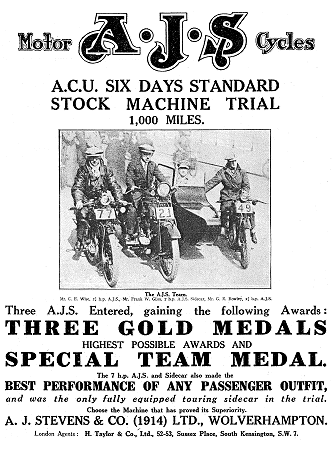
From 'The Motor Cycle', 15th May,
1924. |
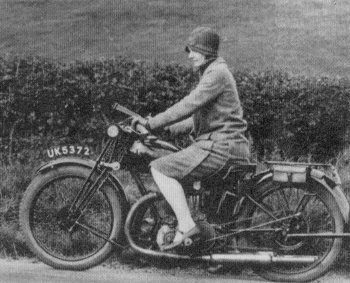
Millie Stevens on her A.J.S.
motorcycle at Enville, in about 1925. |
The machines were as follows: Model ‘E1’ de-luxe 799c.c. V twin passenger combination
selling for £115
Model ‘E2’ standard 799c.c. V twin passenger combination
selling for £90
Model ‘E3’ 349c.c. de-luxe touring machine
selling for £57
Model ‘E4’ 349c.c. de-luxe sporting machine
selling for £57
Model ‘E5’ 349c.c. standard sporting machine
selling for
£49.10s.
Model ‘E6’ 349c.c. overhead valve sports machine selling for
£60
Model ‘E7’ 349c.c. overhead valve special sports machine.
Price according to specification.
|
| The ‘E1’ came complete with a luxurious sidecar fitted
with a glass windscreen, side screens, and a storm-proof
apron. The motorcycle featured Lucas ‘Magdyno’ electric
lighting, and fully enclosed transmission chains. On 21st February, 1925 Frank and Adelaide Giles gained a
special award in the Colmore Cup Trial for second best
sidecar in the trial. Other awards went to George Rowley,
Jimmy Simpson, and D. Brandish, all riding 349c.c. A.J.S.
machines. |
| George Rowley’s father was in charge of the machine shop
at Graiseley Hill. George would go on to become one of the
best competition riders of the day. On 7th March, Frank and Adelaide Giles entered the
Birmingham M.C.C. Victory Cup Trial and won the Victory Cup
and gold medal for the best performance by a sidecar
machine.
The Hackett Cup and gold medal was won at the same
event, by Jimmy Simpson on his 349c.c. A.J.S. machine.
|
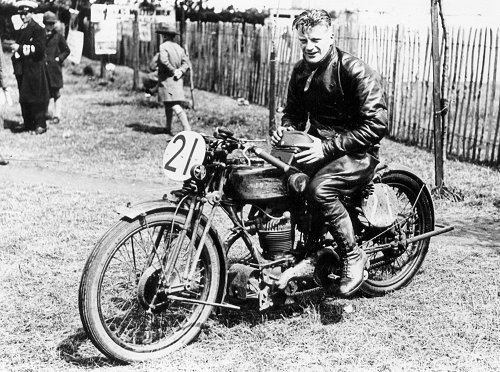
George Rowley on the Isle of Man in
1928. Courtesy of the late Jim Boulton. |
| A number of modifications were made to the machines
entered for the 1925 Isle of Man T.T. due to last year’s
disappointing race. 5 riders were entered for the junior
race; Jimmy Simpson, Charlie Hough, Frank Longman, George
Rowley, and S. M. Williams. Jimmy Simpson had the best race,
finishing in 3rd place, Charles Hough came 4th. |
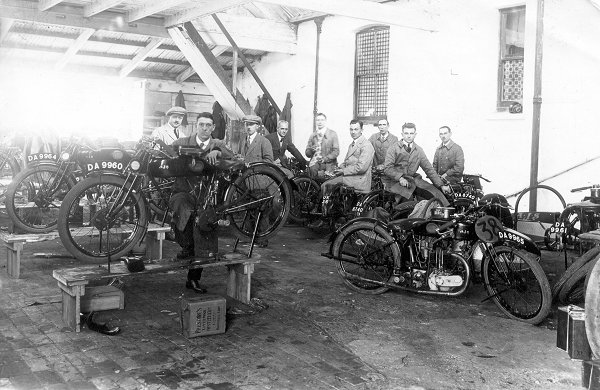
The A.J.S. Isle of Man T.T. workshop
in 1925. Left to right: Joe Stevens junior, Clarrie
Wise, ?, ?, ?, Cyril Greenwood, Arthur Curran, George Rowley, and Jimmy
Simpson.
Courtesy of the late Jim Boulton. |
| There were 3 works entries, and one private entry for the
senior race. The works riders were Jimmy Simpson, Charlie
Hough, and Frank Longman. S.M. Williams competed privately. The only rider to complete the
course was Frank Longman who finished in second place. The
winner was Howard Davies riding an HRD machine. There were also two A.J.S. entries for the sidecar race;
Frank Longman, with Leo Davenport in his sidecar, and
Jimmy Simpson, with George Rowley in his sidecar. They used
349c.c. overhead valve machines with streamlined aluminium
bodied sidecars. At the end of the race, Frank Longman
finished in 4th place, and Jimmy Simpson in 5th place.
Three A.J.S. team members competed in the 350c.c. race in
the French Grand Prix at Montlhéry on Saturday 18th July,
over a distance of 217 miles. They were Frank Longman,
Hanford Stevens (son of George), and Billy Hollowell
(engaged to Hanford’s sister Millie). The race was a great
success for A.J.S. Hanford Stevens finished in first place,
Billy Hollowell came in 2nd, and Frank Longman came 4th. Jimmy Simpson entered and won the 500c.c. race at the
same event, over a distance of 248 miles.
|
|

From 'The Motor Cycle', 14th January,
1926. |
In the Scottish Six Days Trial starting on 27th July,
A.J.S. won the manufacturers team prize for the third year
in succession. During the event Frank Giles and A.F. Downie
won silver cups. One month later the team entered the Belgian Grand Prix
at Francorchamps. Frank Longman and Billie Hollowell
competed in the 350c.c. class, while Jimmy Simpson took part
in the 500cc class.
Tragedy struck on the 5th lap
when Billy Hollowell crashed and died from his injuries. The
other team members were instantly withdrawn from the
competition. This was a terrible blow to the Stevens family,
Millie in particular.
In the autumn 10 new production models were prepared in
readiness for the Olympia Show, prefixed with the letter
‘G’. The range included the company’s first production
500c.c. overhead valve models, the ‘G8’ and the ‘G10’. The
standard version, the ‘G8’ sold for £62.10s. The price of
the racing version, the ‘G10’ was subject to specification.
|
| Sales continued to be high and the total workforce now
exceeded 3,000. There was an excellent relationship between
the management and workforce, and it was decided that the
company needed to encourage social activities outside
working hours.
As a result the A.J.S. Sports and Social Club
Limited was formed after purchasing a piece of land
alongside Woodfield Avenue, in Penn.
The new sports ground
featured a large pavilion with a licensed bar, and room for
dances. There were snooker and table tennis rooms, tennis
courts, and a bowling green.
The company’s ladies and men’s hockey teams held matches
in Pinfold Lane, on a sports ground that was also home to
the Wolverhampton Motor Cycle Football Club, founded by
Tommy Deadman.
Sales of wireless receivers continued to improve and so
the wireless department expanded by moving the cabinet
department into Stewart Street Works.
|
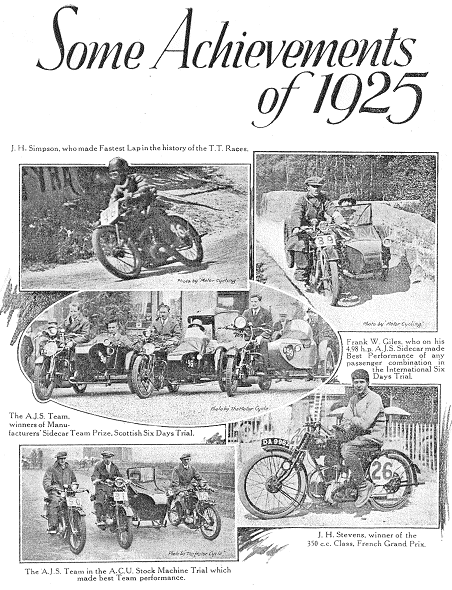
From the 1925 A.J.S. catalogue. |
|
On 28th October, 1925 A.J.S. purchased a piece of land on
the corner of Commercial Road and Lower Walsall Street, on
which stood an old Victorian factory. It is not known if the
building still stood when the site was purchased, or what
the company did with the site.
The year ended with two wonderful pieces of news. H. Dawson
won the both the 350c.c solo class, and the 350c.c. sidecar
class in the Marseilles Speed Championship held on 6th
December. 6 days later Frank and Adelaide Giles won the
sidecar award in the London to Gloucester And Back
reliability trial. Awards also went to W. S. Braidwood, P.
L. Taylor, C. G. Slade, and G. B. Reed, all on 349c.c.
A.J.S. solo machines.
|
| |
|
View a 1925
A.J.S. catalogue |
 |
| |
|
|
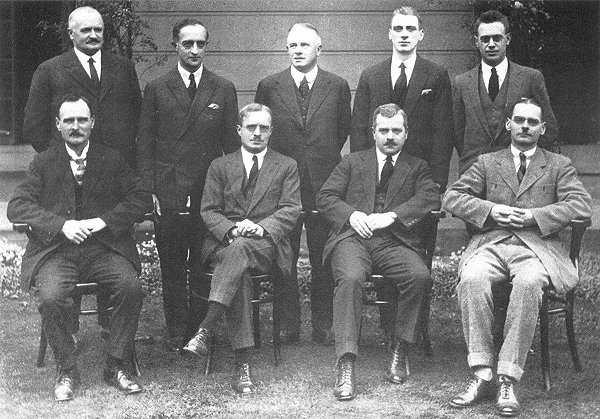
The A.J.S. Directors in 1926.
Back row left to right:
Frank Hill, Edgar L. Morcom, Edgar E. Lamb (Chairman), Charles W.
Hayward and Jabez Wood.
Front row left to right:
Harry Stevens (Engineer), George Stevens (Salesman), Joe Stevens junior (Production Engineer) and Jack Stevens (in
charge of the design office).
Photo courtesy of the late Geoff Stevens. |
| 1926 started on a good note. On 26th January
A.J.S. riders Stuart Williams and Mr. Sidebotham gained
first and second places in the Maroubra Speedway Senior
Grand Prix at Sydney. At the same venue A.J.S. machines came
1st, 2nd, 3rd, and 4th in the Junior Grand Prix. Many other
successes followed, including two silver cups in the
Scottish Six Days Reliability Trial, won by A. F. Downie,
and Frank and Adelaide Giles. Jimmy Simpson also won the
500c.c. class in the Grand Prix D’Europe on 18th
July, and Frank Longman won the 350c.c. class at the same
event. In August Jimmy Simpson won the 350c.c. class in the
German Grand Prix at Berlin, at an average speed of
72.8m.p.h. A strong team had been entered for the Isle of Man T.T.
consisting of George Rowley, Clarrie Wise, Jimmy Simpson,
Charlie Hough, Frank Longman, C. Bell, and J. H. Stevens. In
the junior race Jimmy Simpson finished in 2nd place, Charlie
Hough came in 7th, Frank Longman 8th, C. Bell 18th, and J.
H. Stevens 19th. In the senior race Frank Longman finished
in 3rd place, George Rowley in 6th place, and Clarrie Wise
came in 17th.
The General Strike took place in May at a time of great
industrial unrest. Luckily A.J.S. was hardly affected by the
strike thanks to the loyal workforce and extremely good
relations between management and staff.
In the autumn the new range of production machines was
prepared as usual for the Olympia show. The new ‘H’ series
included 8 solo machines, and two combinations. Prices were
slightly reduced on last year. The top of the range de-luxe
sidecar model now sold for £95, £3 less than in 1925.
|
| In 1927, as in previous years there were many competition
successes. On 3rd and 4th June five A.J.S. machines won gold
medals in the London to Edinburgh Trial, and Jimmy Simpson
won the 350c.c. class in the Grand Prix D’Europe for the
second year in succession. He also won the Swiss Grand Prix,
and the Belgian Grand Prix, 27 minutes ahead of the rest of
the field. In August Frank and Adelaide Giles won the
sidecar class in the
Scottish Six Days Reliability Trial, as
the only sidecar team to finish without losing any points.
As usual the company competed in the Isle of Man T.T. The
T.T. machines used dry sump lubrication, which worked well
in practice, but caused serious problems when racing.
Five out of the nine entries for the junior race failed to
finish, and five out of the eight entries for the senior
race also failed to finish because of engine problems. In
the junior race Jimmy Simpson finished in 3rd place, Len
Cohen in 8th place, S. P. Jackson came in 13th, and J. E.
Wade came in 15th.
|
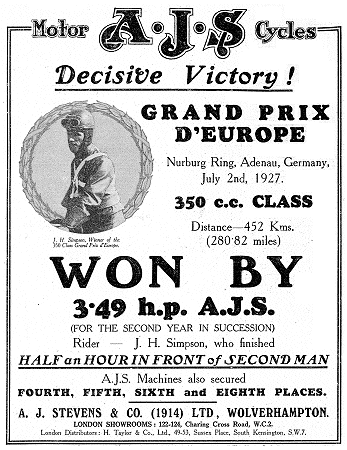
From 'The Motor Cycle', 14th July, 1927.
|
|
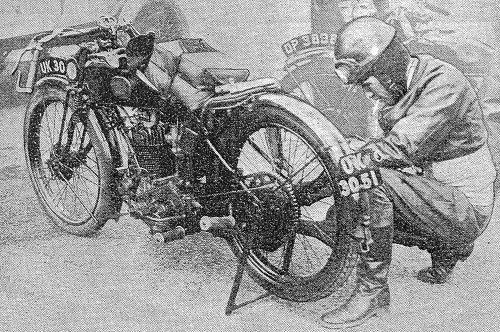
Jimmy Simpson at work on his 1927 T.T.
machine. From 'The Motor Cycle', 5th May, 1927.
|
In the senior race George Rowley finished in 9th place,
Charlie Hough came in 11th, and R. F. Parkinson came in
15th.
The lubrication problem was soon sorted out and the
machines had many successes at Brooklands, in Europe, and at
the Ulster Grand Prix. |
| A.J.S. always relied heavily on sales of the popular
passenger combinations, greatly helped by the many
achievements of Frank and Adelaide Giles in trials and
competitions. |
| In 1927 they continued their winning ways
by gaining first class awards in the A.C.U. Six Days Stock
Trial, the London to Edinburgh Trial, the Scottish Six Days
Trial and many more.
Frank and Adelaide also represented
Great Britain for the 6th year in succession with their
A.J.S. combination. |
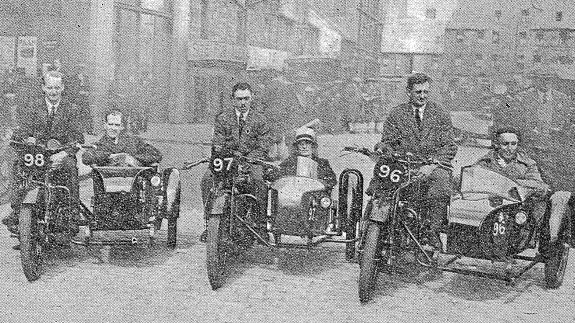
The 1927 Scottish Six Days Reliability
Trial. Riders; A. L. Downie, Frank Giles, and A. F. Downie.
Adelaide Giles is in the middle side car. From 'The Motor
Cycle', 18th August, 1927. |
| The depression had caused a reduction in the sale of
motorcycles, not helped by the appearance of the
attractively priced, mass-produced light car. The wireless
department also suffered from a reduction in sales because
of increased competition, with the introduction of cheaper
mass-produced radios.
One piece of good news came in the form of a lucrative
contract to build car bodies for the largest local car
manufacturer, Clyno. In the summer of 1927 Clyno developed
the model 'Nine' light car. Charles Haywood secured the
contract for A.J.S. to build the bodies at Lower Walsall
Street works. The A.J.S. Board thought that diversification
might be a way of securing the company’s long term future,
after being faced with falling sales. It would also secure
the future of the 1,300 or so staff at Lower Walsall Street.
The Board members decided to develop a range of commercial
vehicle chassis at Lower Walsall Street, under Charles
Hayward’s supervision.
As a result the ailing wireless department moved from
Lower Walsall Street to Stewart Street Works to free-up
space required for building the car bodies, and for
developing commercial vehicles. |

From 'The Motor Cycle', 28th July, 1927.
|
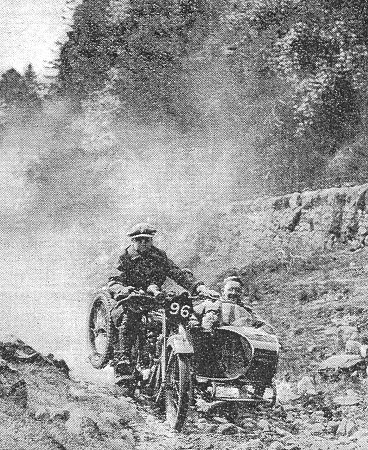
A. F. Downie in action in the Scottish
Six Days Trial. From 'The Motor Cycle', 4th August, 1927. |
As usual, next year’s range of motorcycles, now using the
letter ‘K’ were prepared in the autumn in readiness for the
Olympia show.
The range was similar to last year’s except
for the introduction of two overhead camshaft racing models,
the ‘K7’ and the ‘K10’.
The range of sidecars for 1928 were
to have fabric covered bodies, like the fabric covered car
bodies that were produced for Clyno at Lower Walsall Street.
It had been the worst financial year for A.J.S. so far.
The company failed to declare a dividend to its
shareholders, for the first time in its existence.
|
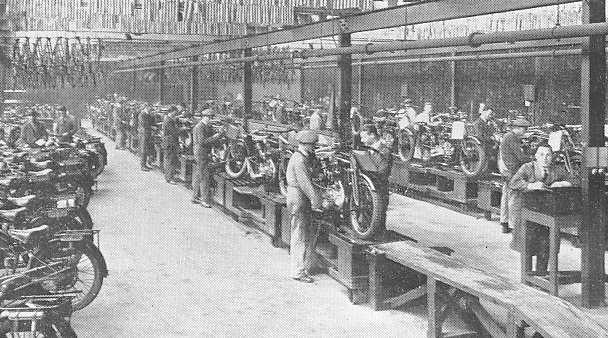
The Erecting Shop at Graiseley Hill in 1927.
| The 1927 product range,
known as series H: |
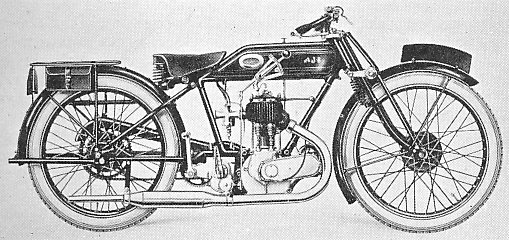 |
The 3.49 hp. standard sporting
model H5, the most popular model in the sports range.
selling price £44. |
| The 3.49 hp. de luxe sporting model
H4, with mechanical lubrication, and a quickly detachable rear
wheel. selling price £48.10s. |
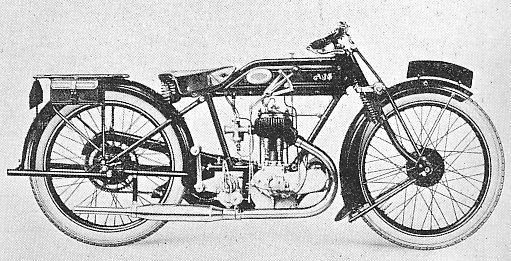 |
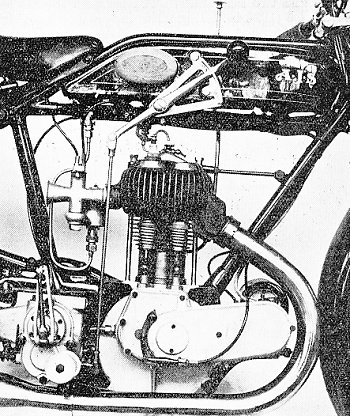 |
A close-up view of the 3.49 hp.
side valve engine in the H5. It is a four-stroke engine with
a bore of 74 mm. and a stroke of 81 mm.
It has a four-ring aluminium alloy
piston, and a cast iron cylinder with a vertically- finned
detachable head. Other features include an extended, finned
exhaust port to give increased cooling, and large valves
made of heat-resisting alloy steel.
The silencer is of a new
cylindrical type that is very effective in reducing exhaust
noise by the use of blind ended and drilled extensions, so
that it is impossible for the gases to flow straight
through. |
| The 3.49 hp. overhead valve
sporting model H6. The machine is identical to the H4 other
than the O.H.V. engine, carburettor, gearbox, and magneto. |
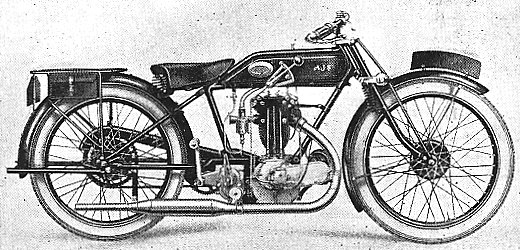 |
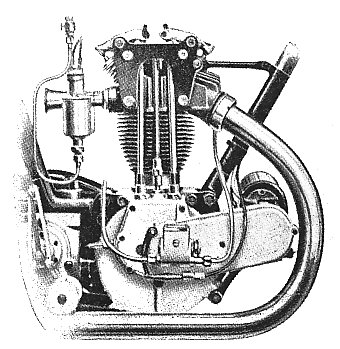 |
A close-up view of the 3.49 hp.
overhead valve engine which has 2 large diameter tulip
valves, a detachable cylinder head, a hemispherical
combustion chamber, and an aluminium alloy piston with 4
narrow width piston rings.
For racing purposes a high compression piston was available. |
| The 4.98 hp. overhead valve
sporting model H8. This model is almost identical to the
A.J.S. machines that performed so well in the Isle of Man
T.T. races. It has a maximum speed of 70 to 75 m.p.h. |
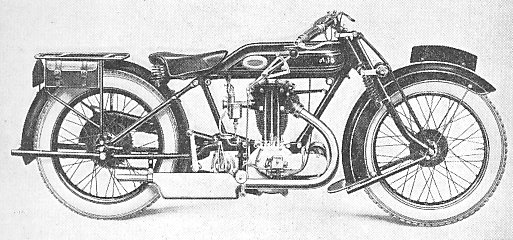 |
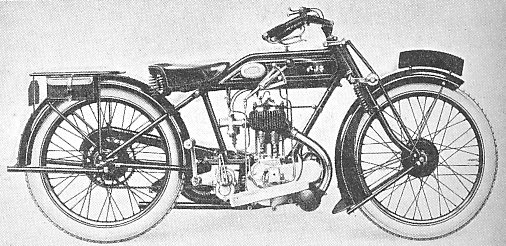 |
The 3.49 hp. de luxe touring model
H3 with footboards and touring pattern handlebars. |
| The 4.98 hp. de luxe touring model
H9 with a side-valve engine. |
 |
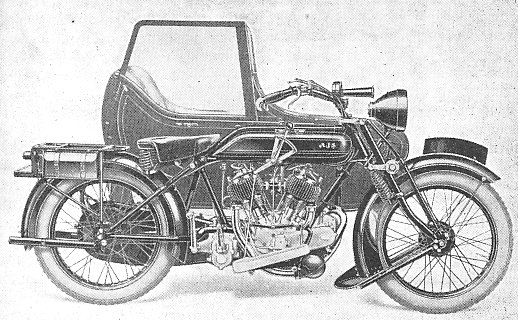 |
The 7.99 hp. de luxe combination model H1. An ideal
touring machine with high horsepower, and low bottom gear,
which can go almost anywhere.
The engine is a 50º
v-twin side valve design with aluminium alloy pistons.
All 3 wheels are quickly and
easily interchangeable, and the sidecar is steel-panelled,
and beautifully upholstered. |
| A close-up view of the v-twin 7.99
hp. side valve engine that powers the H1 combination.
The cylinders have a common induction
manifold to which the carburettor is attached, detachable
cylinder heads, and roller bearings. |
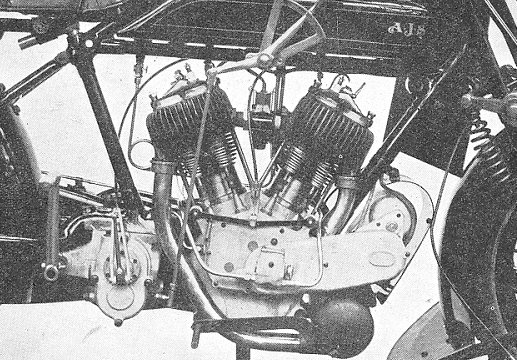 |
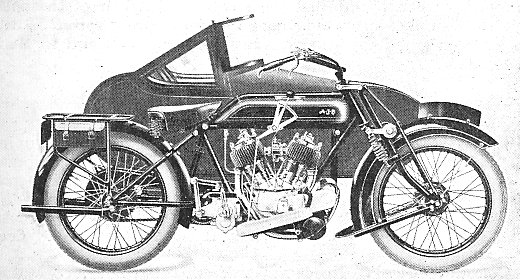 |
The 7.99 hp. standard passenger
combination model H2. This is
a cheaper, less luxurious version of the H1. |
| The 7.99 hp. de luxe tandem
two-seater combination.
This was supplied as a two-seater
sidecar version of the H1 and H2. |
 |
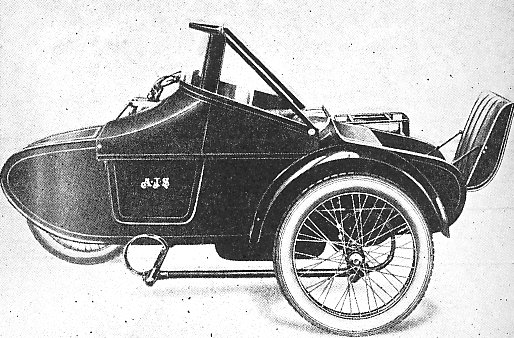 |
The occasional two-seater sidecar
which has a second seat for occasional use. If not occupied,
the rear seat area can be used for luggage.
It sold for £98 when fitted to an H1
machine, or £85 if fitted to an H2.
|
| A sidecar with a child's seat.
It has a safe and compact compartment
at the back for a child, with side panels, so that the child
is as well protected as its parent sitting in front. |
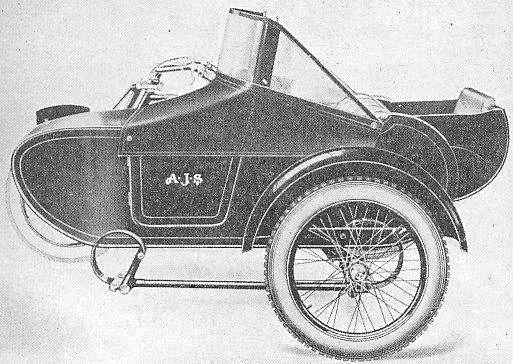 |
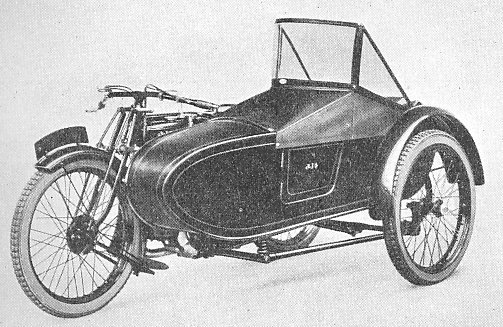 |
The lightweight touring sidecar is
a small sidecar that can be fitted to the 3.49 hp. and 4.98
hp. models. |
| The 4.98 hp. combination consists
of a special touring sidecar with an extra large locker, and
a standard 4.98 hp. machine. |
 |
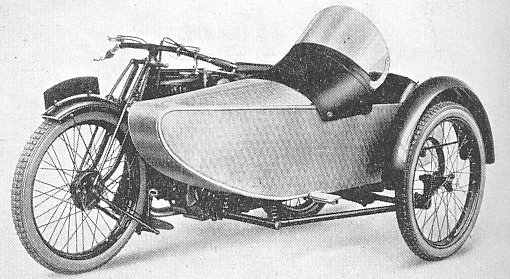 |
The standard aluminium sports
sidecar is roomy, fitted with a spring back, and well
upholstered with a large locker at the rear. It can be
fitted to the 7.99 hp. machines, or to the smaller machines
when fitted with a lightweight chassis. |
| The super sports aluminium sidecar
is light in weight, and streamlined, and can be fitted to
all models. It is ideally suitable for track or road racing. |
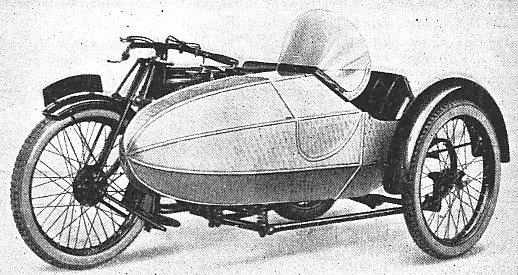 |
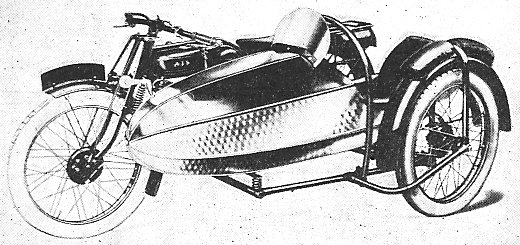 |
The special racing sidecar can be
fitted to all models, and is suitable for the more serious
sportsman. It has special cushions on top of the mudguard,
and a loop frame over the passenger for cornering purposes. |
 |
 |
 |
Return to the
previous page |
Return to
the Beginning |
Proceed to the
next page |
|